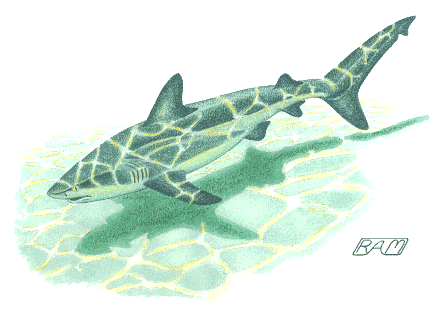Molecular Systematics -
A Powerful New Tool
Molecular systematics is a relatively new field. Sequences of genetic code analyzed by high-speed computers allow systematists to test evolutionary relationships at their most basic level. Studies of mitochondrial DNA (mtDNA) sequences have already revealed some astonishing things about the evolutionary interrelationships of many groups of creatures, from humans to whales to sharks.
Independent mtDNA studies by geneticist Douglas C. Wallace of Emory University and anthropologist Luca Cavalli-Sforza of Stanford University and his co-workers have provided powerful evidence that all human beings, regardless of 'race', are a very closely-related monophyletic group. These studies support the Out of Africa model of human evolution (which argues that all modern humans are descendants of a single lineage that left Africa some 130,000 years ago, spreading over the continents in a straight-forward chronological pattern) over the major competing idea, the Multiregional Hypothesis (which posits that there have been several waves of human migration from Africa to various parts of the world, each of which represents a 'race' that continued to evolve separately). Thus, molecular systematics drives yet one more nail into the outdated notion of racism. Regardless of skin color, we are all Africans.
Studies on cetacean mtDNA by Michel C. Milinkovitch of the Université Libre
de Bruxelles have revealed that the sperm whale (Physeter macrocephalus) is
actually more closely related to baleen
 whales (suborder Mysticeti) than to
other toothed whales (suborder Odontoceti). This study has prompted Milinkovitch
to reassess morphological similarities between the sperm whale and mysticetes
—
including nasal passages, facial and cranial asymmetry - and suggests that the
traditional classification of these whales is in need of revision.
whales (suborder Mysticeti) than to
other toothed whales (suborder Odontoceti). This study has prompted Milinkovitch
to reassess morphological similarities between the sperm whale and mysticetes
—
including nasal passages, facial and cranial asymmetry - and suggests that the
traditional classification of these whales is in need of revision.
Mitochondrial DNA studies have also have revealed surprises about shark interrelationships. A recent study by Katherine A. Dunn and John F. Morrissey of Hofstra University on the molecular systematics of elasmobranchs supports the hypothesis that these fishes represent a monophyletic group, but suggests that the batoids represent a distinct sub-group from the sharks and should not be classified among them as proposed by Compagno, but at the terminus of one of the two main branches of elasmobranch evolution, as proposed by Shirai and de Carvalho.
According to an ambitious 1992 paper by Gavin Naylor, now at Yale University, the interrelationships of the 'confusing carcharhinids' (a group of highly successful generalist sharks that are very similar in appearance) just became a little more confusing. Naylor's analysis of the mtDNA of carcharhinids strongly suggests that the genus Carcharhinus, as traditionally defined, is actually descended from several ancestors and will probably require splitting into two or more genera. Perhaps most surprising of all, Naylor's analysis indicates that the family Carcharhinidae is not monophyletic unless the hammerhead sharks are included. In his 1988 magnum opus, Compagno's cladistic analysis of morphological characters of carcharhinoid sharks also suggests such an arrangement.
As reported elsewhere in these pages (see the individual family profiles under Lamniformes), mtDNA studies have also revealed some surprising things about the interrelationships of the lamnoid sharks.
